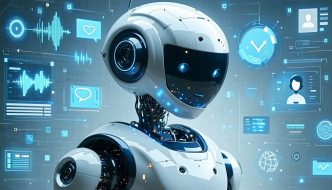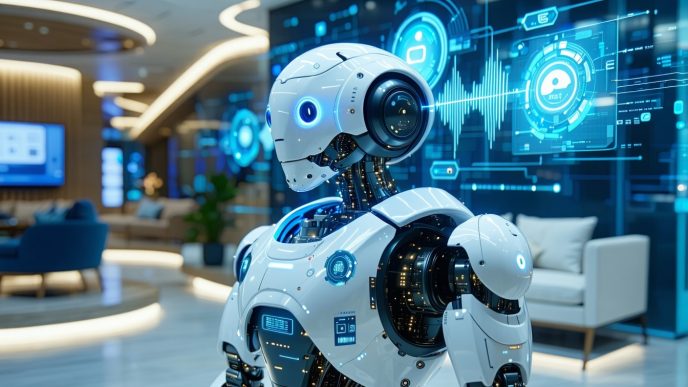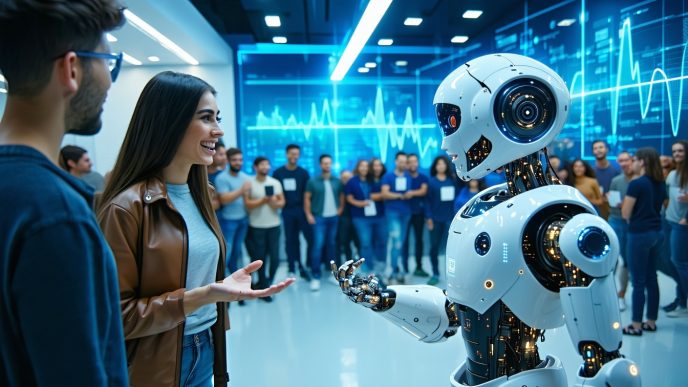Evolution of Voice Responses in Robotics
Importance of Voice Interaction
Voice interaction has become a crucial component of user experiences with robots. It allows for more natural communication between humans and machines, enhancing the usability and acceptance of robotic systems. Utilizing voice commands simplifies user interaction, as many individuals find it easier to speak than to navigate through buttons or screens.
Voice responses are not only functional but also essential for creating an engaging user experience. The ability to converse with robots enables users to maintain a more intuitive and personal connection with these technologies. This aspect is increasingly important in applications ranging from smart home devices to personal assistants in various environments. For insights into how voice interactions are structured within robots, refer to our article on robot voice recognition and nlp.
History and Current State
The evolution of voice responses in robotics can be mapped through significant milestones in technology and user interaction. Early robotic systems utilized simple pre-recorded phrases that would trigger based on specific commands. As technology evolved, the integration of Natural Language Processing (NLP) allowed for more sophisticated interactions.
Here is a brief timeline showcasing key developments in the evolution of robot voice responses:
| Year | Development | Description |
|---|---|---|
| 1960 | Speech Recognition Beginnings | Initial experiments in automated speech recognition. |
| 1990 | Basic Voice Command Systems | Introduction of systems using limited voice commands. |
| 2000 | NLP Integration | NLP technology began to be incorporated into more sophisticated robotic systems, allowing for better understanding of user intent. |
| 2010 | Interactive Voice Assistants | The introduction of smart assistants brought a conversational element to user interactions. |
| 2020 | Advanced NLP Technologies | Machines can now understand contextual clues and respond naturally to user queries. |
Today, the landscape of robot responses is markedly refined. Current systems leverage advanced algorithms for natural language understanding in robots, which enhance their ability to discern user intent and generate appropriate replies. Technologies such as speech to text processing in robots further improve the accuracy of robot responses. Ongoing advancements continue to focus not only on voice command accuracy but also on developing unique personalities and responses tailored to user preferences, illustrating the significance of robot responses and personality design in enhancing user engagement.
As voice interaction technology progresses, it promises to reshape how users will engage with robots and other smart devices in the future. To explore where this technology is heading, consider reading our article on the future of voice interaction with robots.
Understanding Natural Language Processing (NLP)
Natural Language Processing (NLP) is at the core of how robots comprehend and respond to human language. It allows robots to not only recognize voice commands but also interpret them meaningfully and interactively.
NLP in Robotics
In the realm of robotics, NLP technologies have evolved significantly, enabling machines to engage with humans using natural language. These systems analyze spoken or written commands and convert them into actionable tasks. The following table provides a breakdown of some key components of NLP in robotics:
| Component | Description |
|---|---|
| Voice Recognition | Converting spoken words into text |
| Natural Language Understanding | Interpreting user intent and context |
| Natural Language Generation | Formulating appropriate voice responses |
Effective NLP implementation ensures that robots can maintain fluid conversations and adjust responses based on user sentiment and context. This aspect is a vital part of robot responses and personality design.
How Robots Interpret Voice Commands
The process by which robotics systems understand voice commands involves several stages. Initially, when a user speaks, the robot’s voice recognition system converts the sound into text. This text is then processed to determine the intent behind the command. A summary of the stages involved is below:
| Stage | Description |
|---|---|
| 1. Capture | Robot listens to and records voice commands |
| 2. Conversion | Recorded audio is transformed into text |
| 3. Interpretation | NLP algorithms analyze the text for meaning |
| 4. Response Generation | Robot formulates an appropriate reply based on understanding |
In addition to understanding commands, robots continually learn from interactions. They refine their responses over time, enhancing their ability to comprehend varied accents through techniques detailed in our article on training robots to understand accents. Additionally, ensuring high voice command accuracy in robots is essential for a seamless user experience.
As NLP technology continues to advance, the potential for more sophisticated conversation capabilities in robots becomes increasingly possible. For further exploration of this domain, see our discussion on conversation capabilities in robots and the future of voice interaction with robots.
Designing Robot Personalities
The integration of voice responses in robotics is not just about functionality; it also involves creating engaging personalities that enhance user experiences. A well-designed robot personality contributes to more natural interactions, making technology accessible and enjoyable.
Creating Human-like Interactions
To foster meaningful communication, robots are designed to exhibit human-like interactions. This involves simulating conversational cues, emotions, and engagement, which can be achieved through advanced programming and natural language processing (NLP).
Robots achieve this by employing techniques from robot voice recognition and NLP, enabling them to understand and respond to voice commands in a relatable manner. Key attributes that define human-like interactions include:
| Attribute | Description |
|---|---|
| Conversational Flow | Ability to maintain a fluid conversation. |
| Emotional Tone | Use of varied intonation to convey feelings. |
| Personalization | Tailoring responses based on user preferences. |
Implementing these attributes helps in bridging the gap between humans and machines. This is particularly important in settings such as smart homes, where everyday interactions occur. For instance, feedback mechanisms enhance user experience by ensuring that conversations feel dynamic and responsive, as discussed in our section on conversation capabilities in robots.
Balancing Functionality and Personality
While creating an engaging personality is essential, it must not compromise the robot’s core functionality. A well-balanced design ensures that users receive accurate information and assistance while enjoying an entertaining interaction. Balancing these elements requires careful consideration of the following factors:
| Factor | Description |
|---|---|
| User Expectations | Understanding what users desire from robotic interactions. |
| Task Efficiency | Ensuring the robot can perform its designated tasks seamlessly. |
| Interaction Quality | Maintaining a pleasant user experience through effective communication. |
For robots to be effective, they must provide clear responses while embodying a unique personality that enhances user engagement. This is where voice command accuracy in robots plays a critical role. The robot’s ability to accurately interpret and execute commands influences how users perceive its personality and functionality.
Designing effective robot personalities is a multi-faceted process that merges technology and social interaction strategies, creating robots that resonate with users emotionally and intellectually. As advancements in NLP continue, the capabilities of robots will only improve, paving the way for enhanced user interactions. Interested in the future of this technology? Explore our article on the future of voice interaction with robots.
Factors Influencing Robot Responses
Robots’ ability to respond accurately and effectively is shaped by various factors, including the context in which they operate and the level of customization available for users. These elements can greatly enhance the interaction experience.
Context and Environment
Robots interpret voice commands differently depending on the context and environment. This variability is crucial for ensuring effective communication. Context can include factors such as noise levels, the presence of other individuals, and the specific tasks being performed.
For instance, in a noisy environment, robots may rely more heavily on advanced features for speech to text processing in robots to accurately capture commands. The design of the robot’s voice recognition system may also need to factor in background sounds, optimizing the technology to understand users better.
| Contextual Factor | Impact on Robot Responses |
|---|---|
| Noise Level | Requires enhanced sound filter techniques |
| Lighting Conditions | Affects voice command clarity |
| User Proximity | May influence response speed and accuracy |
| Emotional Atmosphere | Can guide the tone and type of responses |
Understanding these contextual elements is essential for developers in creating robots that can interact more naturally.
Customization for Users
Customization plays a vital role in personalizing robot interactions. Users may have preferences regarding how robots respond based on their individual needs and expectations. This customization can involve setting voice tone, style, and even personality traits appropriate for the user’s environment.
Many robots offer features that allow users to tailor responses, thereby improving the overall user experience. For instance, some robots can adapt to different accents, as explored in our article on training robots to understand accents. This adaptability helps in achieving higher voice command accuracy in robots.
| Customization Feature | Description |
|---|---|
| Voice Tone | Users can choose from various tones (e.g., friendly, formal) |
| Personality Traits | Customizable traits such as humor or seriousness |
| Command Recognition | Ability to learn specific commands unique to the user |
| Language Options | Support for multiple languages and dialects |
This level of personalization allows for improved alignment between how a user interacts with a robot and the robot’s functionalities, ultimately enhancing the robot’s conversation capabilities.
By considering both context and individual customization, developers can significantly enhance robot responses and personality design, ensuring a more engaging and intuitive user experience. Further exploration of the evolution of these technologies can be found in our discussion on the future of voice interaction with robots.
Enhancing User Experience
User experience (UX) is critical in the design and function of robots, particularly in how they respond to voice commands. Two key aspects that enhance this experience are feedback mechanisms and emotional responses.
Feedback Mechanisms
Feedback mechanisms play a vital role in how users perceive their interactions with robots. When a robot effectively communicates its understanding or actions through audio or visual cues, users gain confidence in the machine’s capabilities. Feedback can range from verbal acknowledgments to visual indicators, such as lights or displays, that confirm successful command execution.
| Type of Feedback | Description | Example |
|---|---|---|
| Verbal | Spoken responses by the robot to confirm actions or provide information | “I have set the timer for 10 minutes.” |
| Visual | Using displays, lights, or gestures to show the robot’s status | Green light indicates active listening. |
| Sensory | Tactile feedback, such as vibrations or movements to signal actions | Robot vibrates when it completes a task. |
Each feedback type addresses different user needs and helps reinforce trust in the robot’s voice recognition and command execution. For an in-depth look at how robots utilize voice recognition technology, refer to our article on robot voice recognition and nlp.
Emotional Responses
Emotional responses in robots enhance the connection between the user and the machine. Building this aspect into robot design involves creating personalities that resonate with users, fostering a more engaging and interactive experience. When robots exhibit emotional nuances, such as empathy or excitement, they encourage users to respond more positively.
Robots can express emotional states through tone, pitch, and pacing when delivering voice responses. The ability to adapt emotionally to context, such as providing comforting words during a stressful situation, is essential for effective interaction.
| Emotion | Response Style | Example |
|---|---|---|
| Happiness | Cheerful tone, upbeat language | “I’m so glad to help!” |
| Sadness | Soft tone, gentle words | “I’m here for you if you need to talk.” |
| Excitement | Energetic tone, enthusiastic language | “That’s amazing! Let’s explore!” |
Creating a robot that can engage emotionally with users enhances not only its usability but also its perceived personality. For insights into how robots understand the nuances of language, check out our article on natural language understanding in robots.
By integrating effective feedback mechanisms and emotional responses, robots can significantly improve user satisfaction, ensuring that interactions are not only functional but also enjoyable. These principles are fundamental to the ongoing development of voice command accuracy in robots and their overall conversation capabilities.
Ethical Considerations
As voice responses in robots become increasingly sophisticated, several ethical considerations arise. These include privacy and data security issues, as well as the impact of robot interactions on social relationships.
Privacy and Data Security
The integration of voice recognition technology into robotics necessitates the collection and processing of user data. This creates potential security risks, particularly concerning the unauthorized access to personal information. It is critical for developers and manufacturers to implement robust data protection measures to safeguard users’ privacy.
Key aspects to consider include:
| Privacy Considerations | Description |
|---|---|
| Data Collection | How much user data is collected and for what purpose |
| Data Storage | Where the data is stored and how it is secured |
| Data Sharing | Whether user information is shared with third parties |
Users may have concerns about their conversations and interactions being recorded or misused. Clarity in how data is collected, used, and protected can enhance trust in robotic systems. Understanding issues around data privacy can help users feel more comfortable with technology that relies on voice commands. For more information on this topic, refer to our article on robot voice recognition and nlp.
Impact on Social Interactions
The rise of robotic interactions through voice responses influencs social dynamics. While robots can provide companionship or assistance, their role in replacing or mimicking human interactions raises questions about emotional and social implications.
Consider the following impacts:
| Social Impact | Potential Effects |
|---|---|
| Enhanced Communication | Robots can facilitate conversations and aid in social skills |
| Dependency on Technology | Users may become overly reliant on robots for social interaction |
| Social Isolation | Over-usage of robots may reduce real-life interactions |
The balance between utilizing robots for assistance and maintaining genuine human interactions remains essential. Understanding these impacts can guide the design of robot responses and personality to foster positive engagement. For further insights, explore our discussion on conversation capabilities in robots.
As robotics technology continues to evolve, addressing these ethical concerns is crucial for ensuring a positive relationship between humans and robots.
Future of Voice Responses in Robotics
As technology progresses, the future of voice interactions in robotics is increasingly focused on improving the sophistication of robot responses and personality design. Innovations in Natural Language Processing (NLP) are pivotal for enhancing how robots understand and engage with human users.
Advancements in NLP Technology
The capabilities of NLP technology are expanding rapidly, leading to more effective communication between humans and robots. Key advancements include:
-
Deep Learning: Leveraging neural networks, deep learning enhances a robot’s ability to understand context and nuances in human speech. This results in more accurate interpretation of voice commands.
-
Contextual Understanding: Future robots will be equipped to analyze the context of conversations, allowing for responses that are relevant to the situation, place, and individual user preferences. This development is essential for creating a more personalized experience.
-
Multimodal Processing: This approach combines various forms of input, such as voice, text, and visual cues. It enhances robot interactions, enabling them to respond to complex queries and engaging conversations.
| NLP Advancement | Benefit |
|---|---|
| Deep Learning | Improved interpretation of speech |
| Contextual Understanding | Relevant and personalized interactions |
| Multimodal Processing | Responsive to various forms of input |
For an in-depth look at how these technologies integrate, check out our article on robot voice recognition and nlp.
Predictions and Trends
Looking ahead, several trends are anticipated to shape the landscape of robot responses and personality design:
-
More Human-like Interactions: Robots are expected to develop personalities that mimic human traits, making them more relatable. Users will shortly experience robots that can convey emotions through their speech, enhancing the overall interaction.
-
Increased Accessibility: As the technology becomes more refined, it will cater to diverse populations, including those with different accents and dialects. Efforts like training robots to understand accents will ensure that robots can communicate effectively with a global user base.
-
Greater Integration with Smart Home Systems: Voice responses will become a central feature in smart home ecosystems, allowing seamless interaction with various devices. This integration will significantly improve the convenience and functionality of smart home technology.
| Trend | Description |
|---|---|
| Human-like Interactions | Robots with relatable personalities |
| Increased Accessibility | Improved understanding of diverse accents |
| Smart Home Integration | Enhanced interaction with smart devices |
For more insights into the evolving nature of robot conversations, refer to our piece on conversation capabilities in robots.
As these advancements unfold, the future of voice interactions promises to deliver a more intuitive and engaging experience for users, empowering robots to respond not just accurately but also empathetically. Take a look at our article on the future of voice interaction with robots for further exploration of these trends.















